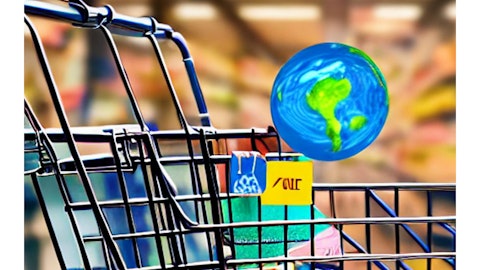These improving usage trends throughout ’23, combined with much healthier economics, give us confidence for 2024. Indeed, many strategic choices made in ’23 will remain at the top of our agenda for ’24 as we see them delivering more impact every quarter. We are not planning a major strategic pivot [ph] as we will mostly focus on executing consistently things that we know are working. The main highlight of our ’24 strategy will be the following. Our primary focus is to execute our growth strategy and achieve healthy growth for the business. Building better supply in our priority categories, improving marketing efficiency and reaching out to customers in secondary cities are the fundamental areas we will remain focused on. These require consistent and strong execution over time.
We will also have a special focus on our two biggest potential markets, Nigeria and Egypt, where we believe that we are well positioned for growth in ’24. We made a few management changes in ’23 in those countries and we are now fully reorganizing supply chain operations in both countries to become more efficient in our logistics and to be able to reach out to more customers. For example, we are soon moving warehouses in both countries. On the growth side, we have the same focus on supply in priority categories in Nigeria and Egypt as we have elsewhere, with strong commitment from brands, local distributors and international sellers. Despite microeconomic challenges in 2023 and 2024, we believe that Nigeria and Egypt still present massive opportunities for e-commerce in Jumia, in Africa, due to very large consumer demands.
Let’s now take a quick look at macroeconomic trends across our footprints. As explained over the past quarters, microeconomic trends remain challenging across Africa. However, we are increasingly confident now in our ability to operate, grow and reduce losses even in challenging environments. I shared three months ago the example of Ghana with one of the highest inflation rates across the continent, where we are now growing double digits year-over-year in both orders and GMV in Q4 ’24. Looking at 2024, we have started to see signs of stabilization and recovery in several markets. This should, over time, make it easier for Jumia to source goods and should improve our customers’ purchasing power. For example, in Nigeria, the government took a number of bold decisions over the past months on critical topics such as exchange rates and fuel subsidies that are expected to be net positive for the economy in the medium-term.
The IMF forecasts an improvement in GDP growth in Nigeria in 2024 from 2.8% GDP growth in ’23 to 3% in ’24. Looking at the whole sub-Saharan Africa, the IMF is forecasting an acceleration from 3.3% to 3.8% GDP growth in 2024. Let’s now look at our progress in building stronger priority categories in physical goods on Page 7. We have identified priority categories in which we want to succeed and become the top choice for consumers across our markets; phones, electronics, home and living, fashion and beauty. These categories were selected back in late ’22 based on simple criteria; relevance to our consumers and market size, ability for Jumia to source supply based on our experience across the 11 countries and expected profitability of each segment, especially taking into consideration challenges in logistics.
This exercise led to the de-prioritization of some categories such as groceries, where sourcing is complex and economics are very challenging for e-commerce. Our focus in 2023 was on developing a better supply chain across these categories using the most relevant methods in each market. Our main topics of attention, as explained last quarter, are seller experience improvements, better planning with key partners, more partnership with international brands such as Starlink, and better collaboration with our sellers based in China. In the last quarter of ’23, we also captured a number of opportunities to import directly from key international brands in home and living and electronics, mainly in Egypt but also in Morocco. This gave us an edge in supply and pricing for B2C consumers as well as the opportunity to make corporate sales to distributors and smaller retailers.
We are seeing the impact of these actions with a significant shift in our category mix over the course of 2023. The share of GMV from home and living and electronics has significantly increased. This is the result of clear focus, consistent execution and strong relationships with both international brands and local distributors. Fashion and beauty categories account for over half of our items sold and are instrumental in driving more frequent usage with healthy margins. We believe that there is still significant upside potential in improving supply, mainly from China via Jumia Global, as well as from several international fashion brands extending across Africa with Jumia. This shift in mix has led to an increase in average order value from $40.6 in Q4 ’22 to $45.5 in Q4 ’23.
Although we do not set specific AOV targets, this increase is helping us to generate a greater profit per order after logistics. We are happy to see the early impact of our actions on supply. The priorities set for ’23 to improve our value proposition in priority categories will remain at the top of the agenda for 2024 as well. Moving on to marketing efficiency now on Page 8. Improvement of our value proposition, in particular thanks to progress made with respect to our supply chain, allows us to drive growth in more healthy ways, especially on the marketing side. As explained in the previous calls, we have made significant changes in the way we use marketing at Jumia. Back in December ’22, we decided to reduce sharply our expenditure in marketing and various consumer incentives such as free shipping.
This decision might have come across as very unusual in the e-commerce industry, and many believed that we would start feeling the pain later in ’23 when the delayed impact of high marketing spend in ’22 would fade away. However, after four full quarters of greatly reduced marketing expenditure, the picture is becoming quite clear. First, the repurchase rates of new customers and physical goods has increased despite reduced amounts of consumer incentives, and this is very important because consumer incentives such as vouchers and free shipping used to be used a lot to stimulate more frequent purchases. The 30 days repurchase rate of our Q4 ’23 cohorts for new customers across all categories has increased by 1 percentage point compared to the same cohort of ’22.



